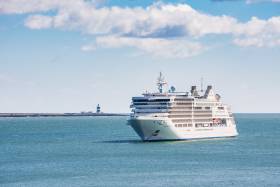Displaying items by tag: Port of Waterford Company
Record Operating Profits at Port of Waterford for First Half of 2017
#ports&shipping - Record operating profits at the Port of Waterford amounted to €964,000 for the first six months of this year, up substantially from the same period in 2016.
Turnover at the company increased by 21% to €3.8m for the first half of the year.
One of the major contributors to the increased turnover was additional bulk throughput with total bulk tonnes up to 701,992 for the six months, an increase of 30% on the equivalent period a year ago.
Growth was experienced across all products handled with animal feed and project cargo activity performing particularly strongly.
The commercial state company has also recently published its annual corporate plan update covering the years to 2021. This envisages activity and profitability increasing significantly with annual revenues targeted to reach almost €10m and capital investment of €5m forecast.
Ship arrivals in the six months to June 30 were up 19% on the first half of 2016 and an additional three people are now directly employed by the Port.
An economic study on the cruise business in the southeast is underway and as Afloat reported yesterday saw a maiden call to an Irish port by the newly-commissioned Silver Muse off Dunmore East.
The company also continues to work with the southeast’s local authorities and a wide group of other stakeholders to advance the region’s economic agenda.
Looking at the first half performance in 2017, Frank Ronan, Chief Executive, Port of Waterford, said: "The ongoing success of our partners in the bulk sector has helped deliver a strong trading performance. In other parts of the business, we are working hard to attract additional container services and to find ways to grow our share of the cruise market. The support of our various allies in the region is key to our success and we will continue to work in close partnership with all of our stakeholders."
The Port of Waterford Corporate Plan 2017-2021 is available at www.portofwaterford.com
#PortofWaterford – A port snapshot of shipping activity on Waterford Estuary this morning revealed an eclectic range of vessels between the city-centre quays to the open sea, writes Jehan Ashmore.
Departing the city where a pair of Royal Navy 'Archer' class fast-patrol cadet training boats, HMS Pursuer (P273) led by HMS Charger (P292). The sisters had visited the 100-berth Waterford City Marina on the historic quays providing easy access to visitors to Ireland's oldest city established by the Vikings.
As the naval pair departed downstream off The Island (Waterford Castle Hotel) they met the inbound Katrion, a 38m long luxurious motoryacht. The 10-guest capacity vessel built by Dutch yard Feadship had visited Glengariff as reported and subsequently Kinsale.
She completed her passage to moor at Merchants Quay along the city's mile long quay, described by the eminent architectural historian, Mark Girouard, as "the noblest quay in Europe".
Larger vessels such as Atlantic M a livestock-carrier is docked at Belview Container Terminal, the main port of Waterford. She trades to Libya along with sister Express 1 which as previously reported was detained in the UK earlier this year.
The Port of Waterford offers an inter-modal connection at Belview as Irish Rail (Iarnród Éireann) freight-trains from Ballina, Co. Mayo make an onward link to northern Europe through 'liner' shipping services operated by DFDS Logistics to Rotterdam.
The rail-sea service was re-launched in early 2013 and a year later the inter-modal service has been hailed a success according to Irish Rail.
To maintain sufficient depths the port has contracted the WD Mersey which is carrying out dredging work off Cheekpoint where the confluence is of the rivers Suir and Nore.The dredged spoil is disposed further downriver offshore of Dunmore East.
Wind Surf, a four-masted cruiseship is scheduled to call by anchoring in the harbour mouth offshore of Dunmore East on 11 July.
Probe into Death of Seaman at Waterford Port
An investigation has been launched into the death of a seaman in Waterford Port yesterday.
The Irish Independent reports that the 51-year-old sailor from the Philippines fell more than five metres after being struck by machinery.
He had been tying down a load on the cargo ship MV Scot Pioneer when the incident occurred around lunchtime yesterday. He later died from his injuries.
The Health and Safety Authority and gardaí went to the scene, and RTÉ News reports that a post-mortem was set to take place yesterday afternoon.
The Port of Waterford Company also issued a statement extending its sympathies to the man's family and colleagues.


























































